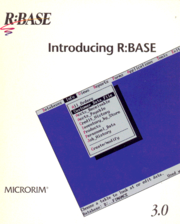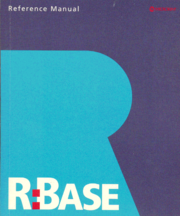
R:Base
Encyclopedia

Relational database
A relational database is a database that conforms to relational model theory. The software used in a relational database is called a relational database management system . Colloquial use of the term "relational database" may refer to the RDBMS software, or the relational database itself...
program for the PC
Personal computer
A personal computer is any general-purpose computer whose size, capabilities, and original sales price make it useful for individuals, and which is intended to be operated directly by an end-user with no intervening computer operator...
. Created by Wayne Erickson in 1981, the original R:Base database was written on a Heathkit CPM computer that Erickson built at home. On November 13, 1981, Erickson and his brother, Ron Erickson, incorporated the company, MicroRim, Inc. to sell the database. MicroRIM. (the RIM was an acronym for Relational Information Management,a mainframe database developed at Boeing Computer Service by Erickson and used by NASA
NASA
The National Aeronautics and Space Administration is the agency of the United States government that is responsible for the nation's civilian space program and for aeronautics and aerospace research...
to track the heat shield tiles on its space shuttle
Space Shuttle
The Space Shuttle was a manned orbital rocket and spacecraft system operated by NASA on 135 missions from 1981 to 2011. The system combined rocket launch, orbital spacecraft, and re-entry spaceplane with modular add-ons...
s.) Privately funded and ultimately venture backed, the MicroRim database products achieved significant market share in the mid-1980's in what was dubbed by some, the "database wars" between R:Base and the market share leader, Ashton-Tate
Ashton-Tate
Ashton-Tate was a US based software company best known for developing the popular dBASE database application. Ashton-Tate grew from a small garage-based company to become a multinational corporation...
's D-Base. One clever MicroRim ad stated "R-way versus D-hardway," a jab at the inferior D-Base architecture. MicroRim adhered to the rules of the father of relational database technology, Edgar F. Codd
Edgar F. Codd
Edgar Frank "Ted" Codd was an English computer scientist who, while working for IBM, invented the relational model for database management, the theoretical basis for relational databases...
and prided itself on the elegance of its code.
In the mid-1980s, when Microsoft did not have their own database, they obtained a license to resell R:BASE in Europe so they could have a full suite of software products.
In June 1998, R:BASE Technologies, Inc. (a privately held company in Murrysville, Pennsylvania, USA) acquired the R:BASE products from Abacus Software Group.
Some of the features included, and continue to include, a programming-free application development wizard, automatic multi-user capabilities, a full-featured 4GL programming language
Fourth-generation programming language
A fourth-generation programming language is a programming language or programming environment designed with a specific purpose in mind, such as the development of commercial business software. In the history of computer science, the 4GL followed the 3GL in an upward trend toward higher...
, form, report and label designers, and a fully ANSI
Ansi
Ansi is a village in Kaarma Parish, Saare County, on the island of Saaremaa, Estonia....
SQL
SQL
SQL is a programming language designed for managing data in relational database management systems ....
compliant relational language capability.
Since September 2007, R:BASE is available as R:BASE for Windows v7.6, R:BASE for DOS v7.6 and R:BASE Turbo V-8 for Windows. The Version 8.0 has an extended address management for file handling and is able to cover databases up to 2.3 million TB versus V7.6 which covers databases up to 2 GB. A German kernel has existed since R:Base V7.6.
R:BASE 4000
The earliest version released by Microrim was called R:Base 4000 and was released in 1983. It worked with early version of Microsoft MS-DOS or IBM PC-DOS (version 2 or above). It shipped with a binder-type manual and the program on 360K floppy disks. The system being DOS-based, the interface was entirely text with the exception of DOS line-draw characters.In spite of its relative ease of use and ability to create useful forms and reports, the first R:Base did not have a conventional programming language, but instead relied on SQL statements to accept input and produce output. The lack of a complete programming language meant that the product was not well received by some portions of the market. This may have helped the early, barely relational, dBase products to become dominant. The product was quickly upgraded to include Added Variables and a conventional programming Language (IF, WHILE, etc.) to the original SQL based language The update was released as R:Base 4000 Version 1.1 in March 1984. R:Base became the second most popular DOS database in the PC market (behind dBase).
Portions of the program allowed the user to design screens, called "Forms" in R:Base. Line-draw characters could implement buttons or boxes that would group text on screen. A separate utility allowed the design of printed output formats and was called "Reports." The report design system allowed a user to define and edit fields included in database reports on screen. Limited printer support was included as DOS programs each had their own unique printer driver for similar printer engines. A markup language allowed italics and bold output if the corresponding printer had a capability. Reports could be piped to the display or a serial port for testing if one were so inclined. Database names were constrained to seven characters. The actual data were contained in three files. In an example database named Sales, files name SALES1.RBF SALES2.RBF, AND SALES3.RBF would contain the database. Forms and reports were stored in files external to the database file.
By default, the application would start with a menu asking which database file you wanted to open. Using a startup switch, R:Base could be run entirely from a command prompt, called the "R-prompt," in system documentation. The application command prompt was an "R>" although this could be modified to other characters by editing a configuration file. In an example database named Sales, to query the database, you would first open it by typing "OPEN SALES" at the R-prompt. Using SQL-style queries, one could pull on-screen displays of data from tables. "SELECT FNAME LNAME CITY ZIPCODE FROM MAIN" would display one screen of data from the fields FNAME LNAME CITY ZIPCODE from the table named MAIN. Pressing the space bar would scroll to the next 24 records. A built-in help system produced text after the R> prompt if your query was invalid or the syntax was not understood by the database engine.
A feature of the program was its ability to create applications that ran scripts generated by an internal scripting system. Scripts were stored in files with an extension .APP. The system would first ask for type of menu desired, (one option was pull-down, for example,) then asked you to fill out the pull down headings. Next, you were stepped through a list of actions for each menu choice. At the end, the procedures that had been stepped through were recorded in the database file and could be called from an automatically generated menu system. To prevent a user from tampering with the generated script, an encoded version was created. The user could password protect the encoded version for configuration management.
A utility called File Gateway allowed import and export of common file formats of the era such as Data Interchange Format (DIF), SYLK, Lotus 1-2-3, and dBase files. Another utility, called Recover, was intended to recover damaged R:Base databases.
R:BASE 5000, R:BASE 2.0
R:Base 4000 was followed by R:Base 5000, which substantially improved features and gained wider acceptance.R:BASE 2.0 rolled out a new file format and introduced the ability to use memory above 640K. There was support for the Intel 80286 processor. The system had substantially better documentation. This version continued the evolution toward full ANSI SQL compliance. Forms, scripts, and reports were rolled into the database files. Three files with extensions .RB1, .RB2, and .RB3 contained everything for a single database.
R:BASE 3.x

Convergent Technologies Operating System
The Convergent Technologies Operating System, also known variously as CTOS, BTOS and STARSYS, was a modular, message-passing, multiprocess-based operating system.-Overview:...
operating system, this was apparently a follow-on to Burroughs Teechnologies Operating System (BTOS).
By purchasing license packs, the database gained a multi-user capability in five-user increments. This included a sophisticated (for a DOS application in the day) record-level locking scheme. To work properly, the multi-user database had to be on a file server with all users accessing the database through a network. It was not true client-server because processing occurred in the clients. The configuration file expanded to allow language support and user-defined re-mapping of characters. For example, German characters such as the letter "ö" (o with an umlaut) could be remapped to the string oe. There were character fold tables and sort orders could be adjusted by the user. An "unlimited number of licenses" runtime version was offered, allowing developers to sell applications and include the run-time R:Base engine.
Example of an R:Base 3.1 command prompt transaction asking the application to list the structure of a database table of California cities, (CALIFCY):
R> LIST CALIFCY
# Name Type Index Expression
1 STATE TEXT 2
2 FEATURE TEXT 85
3 FEATURET TEXT 9
4 COUNTY1 TEXT 15
5 FIPSST TEXT 2
6 FIPSCO TEXT 3
7 LATITUDE TEXT 7
8 LONGITUD TEXT 8
9 LAT_DEC TEXT 8
10 LON_DEC TEXT 10
11 SOURCELA TEXT 7
12 SOURCELO TEXT 8
13 SOUR_lat TEXT 8
14 SOUR_lon TEXT 10
15 ELEVATIO TEXT 5
16 FIELD16 TEXT 8
17 MAPNAME TEXT 27
18 LAT1 DOUBLE
19 LON DOUBLE
20 ITEM_NO DOUBLE
Current number of rows: 7070
R>
R:BASE 4.x


First R:BASE for Windows
The first product produced by Microrim for use in Microsoft Windows was named R:Base for Windows. This rolled out in 1994. This version was compatible with R:Base 4.5 files and was fully ANSI SQL Level II 1989 compliant. The application was partially ANSI SQL 1992 Level II compliant. The screen capture images in documentation look like Windows 3.1, but documentation claimed it would also run on Windows 95Windows 95
Windows 95 is a consumer-oriented graphical user interface-based operating system. It was released on August 24, 1995 by Microsoft, and was a significant progression from the company's previous Windows products...
or the more trustworthy Windows inside OS/2 Warp version 3. A variety of run-time licensing schemes were available to developers.
Current Generation R:BASE Products
- R:BASE 7.6 for Windows
- R:BASE 7.6 for DOS
- R:BASE Turbo V-8 for Windows
- R:BASE 9.1 for DOS
- R:BASE eXtreme 9.1 (32) for Windows
- R:BASE eXtreme 9.1 (64) for Windows
External links
- R:BASE Technologies, Inc.
- R:BASE Technical Articles
- R:BASE Sample Applications
- http://www.rbase.com/history/boxes/microsoft/microsoft_1.jpg
- http://www.rbase.com/history/boxes/microsoft/microsoft_2.jpg
- http://www.rbase.com/history/boxes/microsoft/microsoft_3.jpg
- http://www.rbase.com/history/boxes/microsoft/microsoft_4.jpg

